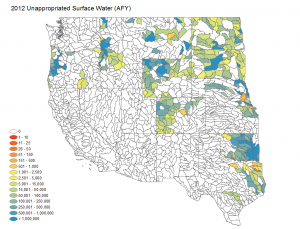Unappropriated Surface Water Metric
States exercise full authority in matters pertaining to off-stream water use. In the western states water is managed according to the principle of prior appropriations, which defines a system of priority where the first to make beneficial use of water has the first right to it in times of drought. Access to this water requires only a permit or water right issued by the state’s water management agency. However, any new water development is allocated the most junior priority in the basin, thus delivery in times of drought may be limited. Whether water is available for new development depends on characteristics of the physical water supply, the water rights structure in relation to supply, and related interbasin/instate compacts and international treaties. Additionally, navigational or environmental regulation may further limit allocation or timing of deliveries. Particularly in arid regions the states have estimated how much surface water is available for new development. Although the states have different terms for such water, we refer to it as unappropriated surface water.
For purposes of this analysis, state estimated unappropriated surface water values are adopted. Such estimates were available for Arizona, Colorado, Nevada, New Mexico, Oregon, Utah, and Wyoming. Estimates of available unappropriated surface water are based on years with normal stream flow. Although availabilities based on drought flows would yield a more dependable estimate for new development, such estimates were available only for a single state. For states that have not estimated unappropriated surface water availability, efforts were made to first identifying basins closed to new appropriation, in such cases available unappropriated water is set equal to zero. In the remaining open basins, stream flows tend to be large with respect to water use, thus environmental concerns are the most likely factor to constrain new water development. A widely used standard in the U.S. (Reiser et al. 1989) is based on studies by Tennant (1976) which found streams to maintain excellent to good ecosystem function when stream flows are maintained at levels of ≥60-30% of the annual average. For this study we adopt a conservative threshold of 50% to define unappropriated surface water. Thus for basins where estimates are not available directly from the states, unappropriated surface water is calculated as:
where j designates the watershed, Qavg is the long term annual average gauged stream flow, C is the total consumptive use of water upstream of the gauging point. Annual average stream flow data are taken from the National Hydrography Dataset (Stewart et al. 2006) while consumptive water use data are taken directly from individual state estimates.
Unappropriated Surface Water Cost
No costs are assigned to unappropriated surface water. It is recognized that there are costs associated with constructing intake structures and permitting. Such costs are not considered in part because of the wide range of variability across use types and location. More importantly, similar intake and permitting costs will be realized with all five sources of water, thus estimating these uncertain costs are of little value to this effort.
References
Reiser, D. W., T. A. Wesche, and C. Estes. 1989. Status of instream flow legislation and practice in North America. Fisheries 14(2):22–29.
Stewart, D.W., A. Rea and D.M Wolock, 2006. USGS Streamgages Linked to the Medium Resolution NHD Geospatial Data Presentation Form: Vector Digital Data. US Geological Survey DS-195.
To view the sources and processes used to calculate estimates for all metrics, select a state below:
ADWR Basin Water Demand and Supply Data (1991-2009)

